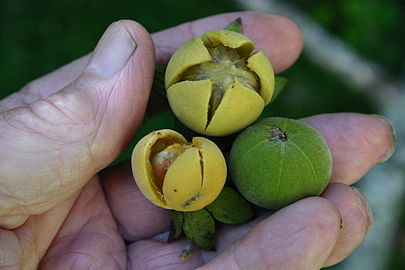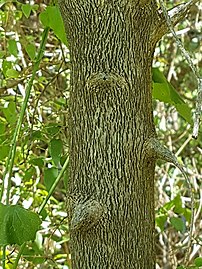Diospyros dichrophylla
| Diospyros dichrophylla | |
|---|---|

| |
| Scientific classification | |
| Kingdom: | Plantae |
| Clade: | Tracheophytes |
| Clade: | Angiosperms |
| Clade: | Eudicots |
| Clade: | Asterids |
| Order: | Ericales |
| Family: | Ebenaceae |
| Genus: | Diospyros |
| Species: | D. dichrophylla
|
| Binomial name | |
| Diospyros dichrophylla | |
| Synonyms | |
|
Royena dichrophylla Gand. | |
Diospyros dichrophylla (
Description
The genus Diospyros includes some 700 species, many of which are ornamental and many which bear edible and often cultivated fruit.
This species grows into a medium-sized tree of up to 15 m tall. It is multi-stemmed and forms a dense canopy. The bark is greyish-brown, and smooth to slightly wrinkled, occasionally armed with robust, wooden spikes which are the remains of the bases of former branches. The young growth is covered in yellowish hairs with a velvety texture.
The simple leaves are alternate, and oblong to oval with bluntly pointed or rounded tips, glossy, dark green above and pale green below. The leaf edges are often tightly rolled under.
The creamy-white flowers are bell-shaped and pendulous, occurring between November and March, are
Some authors describe it as being poisonous, which is puzzling as generally ripe fruits from this genus are quite tasty and edible, though green fruits are rich in
Distribution and habitat
This species is common in coastal scrub, on coastal sandy flats, and along the edges of forests. It is found along a wide coastal belt from Montagu and the
.It prefers moist regions with a high rainfall. (See distribution map)
Gallery
-
Fruits
-
Seeds
-
Bark
-
Spines
References
- ^ The Plant List – Diospyros dichrophylla (Gand.) De Winter, accessed 2015-12-18
- ^ "Diospyros dichrophylla | PlantZAfrica.com". www.plantzafrica.com. Retrieved 2017-08-04.
- ^ "Diospyros dichrophylla Gand. de Winter [family EBENACEAE] on JSTOR". plants.jstor.org. Retrieved 2017-08-04.




